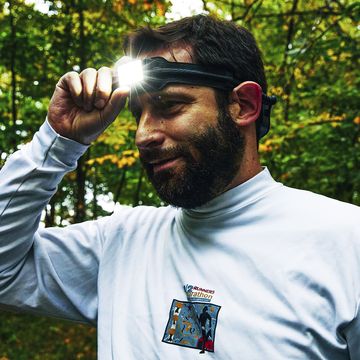Courtney Dauwalter had an extraordinary 2023—she was the first athlete to win Western States 100, Hardrock 100 and the Ultra-Trail du Mont-Blanc (UTMB) in the same year—those races are ultramarathons—each just over 100 miles.
Feel inspired by greats like Dauwalter or your running friend who casually runs ultras for fun? Great! You will likely be happy to know that Dauwalter is not aggressive about her training. Keep that in mind and maybe you, too, can run an ultramarthon.
What Runners Love About Ultramarathons
The number of runners taking on ultras is on the rise. In fact, more than 611,000 runners participated in ultras in 2020, according to a survey from RunRepeat and the International Association of Ultrarunners.
As you can imagine, finding a location to run 100 miles can be a challenge, and that’s one reason most ultramarathons are off-road. Also, because they take so long, there are pre-dawn start times, too, and, yes, they take a long time—Dauwalter’s record-setting Western States run took over 15 hours. How long does it take the average runner? Somewhere between 24 and 36 hours. With so few participants and such a long time on the course, one thing ultramarathoners notice is a lot of camaraderie in their sport.
“The vibe on the course is super-friendly and supportive. Often, it feels like a progressive dinner party under the stars as you move from aid station to station with your pacers, crew, and newly made friends,” Susie Crossland-Dwyer, an ultrarunner, coach, and founder of studio s, a strength, Pilates, and run coaching studio in Cincinnati tells Runner’s World. She’s coached runners, including ultrarunners, for more than 15 years and in 2017, ran six mountain ultramarathons on five continents.
“I often find myself thinking of ultramarathoning as a different sport than road running because the focus of most athletes is altogether different,” Crossland-Dwyer adds. “The community and non-competitive element of ultrarunning tends to be front and center.”
Sounds pretty welcoming when you put it that way. Keep reading for more about what exactly makes ultrarunning unique and how to prep for an ultramarathon.
What is ultrarunning and ultramarathons?
An ultramarathon is any distance longer than a marathon—26.2 miles. Some popular races are 100 miles while others are 200-plus miles over multiple days. The shortest traditional ultramarathon is 50K, or 31 miles. That’s a great place to start if you’re a marathoner looking to dip your toes in the ultrarunning water, says Don Reichelt, who has placed first in races like the 2019 Lean Horse 100 and the 2022 Coldwater Rumble 52 miler; his personal best in the 100-miler is 13:16:55 (that’s an average 7:58 per mile pace).
The biggest difference between ultramarathons and traditional marathons is the complexity of the training schedule, says Reichelt, and that most ultras are trail-based.
Are you ready for an ultramarathon?
If you’re interested in tackling an ultramarathon, you’ve likely crossed the finish line of at least one, if not several, marathons—and that’s very important. So is progressing to longer distances gradually.
“I encourage athletes to have a few seasons of marathon running under their belt before jumping to ultra-distances, and I like to see athletes sequentially increase their training volume or mileage over multiple seasons when moving from the marathon to ultras,” says Crossland-Dwyer. “This aids with injury prevention and helps athletes learn how to handle multiple hours of running before layering on new elements like trail-running technique, varied terrain, elevation gain and loss, and altitude.”
Another significant part of making sure you’re ready to take on an ultra is to start prepping mentally, and a good place to start is on the sidelines of an ultramarthon. “For someone new to ultras, the first thing you should do is volunteer to crew, pace, or work an aid station at an ultramarathon,” Mark Wooten, Life Time run coach and ultrarunner who’s done races like the Badwater Ultra tells Runner’s World. You’ll understand how important mental toughness and a solid race strategy are to finishing an ultramarathon.
What does training for an ultramarathon look like?
Ultras may sound like a totally different beast than the marathon—and they are—but training for one isn’t all that different. “Don’t expect to spend four times the amount of hours training for a 100-miler because it’s four times as long as a standard marathon,” says Wooten. “In terms of training time, a marathon plan and an ultramarathon plan would generally be about the same amount of weekly hours. The big misconception to clear would be the idea that training would be proportional to distance.”
That being said, the type of running you do will shift somewhat. There may be some back-to-back long runs on consecutive days to prep your body to run on tired legs, though you don’t need to do that every week.
Wooten says there’s varying schools of thought regarding two long runs per week. “Some runners and coaches swear by them and have success this way,” he says. “For my personal training plans, I subscribe to the school of thought of quality over quantity, and one long run per week is sufficient.” Figuring out what works best for you might take some trial and error in training.
You might not incorporate speedwork every week, or if you do, the paces will be less aggressive (no sprint repeats necessary when you’re training to cover 50 or 100 miles). “The biggest shift most marathoners have to make when transitioning to ultras is not focusing as much on standard training paces but getting more acquainted with running comfortably,” says Crossland-Dwyer.
Any speedwork you do will also be longer. “For an ultrarunner, timing a 5K or 10K could count as speedwork as it would still be significantly faster than race pace,” says Wooten, who says the goal of speedwork during ultra training is just to make race pace feel more sustainable over those long miles.
Your training plan can and should vary a lot, depending on what race you’re prepping for and what the terrain will be like. If your race is on trails, you should aim to go off-road for at least one run per week. And if the course is mountainous, practicing similar changes in elevation during training is also a smart move, Crossland-Dwyer says.
When you do move to the trails, don’t be disappointed if you can’t maintain your regular on-road pace; most runners slow down by 20 to 30 percent or even more when moving to trails, she adds.
Also, make a point of getting in regular strength and mobility training, advises Reichelt, who does at least a few minutes of strength training most days. “Ultrarunning can and will highlight any weaknesses or asymmetries in your body,” he says. “Basic bodyweight strength training and regular mobility work can help keep those issues away.”
Finally, it’s important to note that because most people who run ultramarathons have a strong running base and regularly clock long miles, an ultramarathon training plan is much less structured. “Training duration is one area where the typical marathoner versus the typical ultramarathoner differ in the greatest of ways. Marathon training plans are much more rigid and analytical versus ultramarathon plans that are loose with lots of flexibility,” Wooten says. “Flexible training plans are also further supported because, for most ultramarathoners, a finish is a win. Seconds don’t matter as much, and the mental strength to finish has more value than physical strength.”
Ultramathon Recovery
“For ultras, we’re generally running at an easier pace; therefore, our stride length isn’t as long, which means less ground impact force,” Wooten explains. “We’re also incorporating walks into our weekly mileage, which are naturally lower impact, and we typically do a large portion of our mileage on a softer dirt surface that’s much more forgiving than concrete.” This schedule, terrain, and intensity allows for some built-in recovery for your ultramarathon training, which can help you sidestep injury. But you’re still running very long distances, so you need your rest time to live up to your mileage.
That means you can consider training for an ultra as your hall pass to soak up all the R&R. Massages, foam rolling, and getting plenty of quality sleep are all important for helping your body bounce back from all the miles. Don’t skip out on active recovery, either, like a restorative yoga class, easy-paced bike ride, or swim in an extra-cold pool. “Those will all pay big dividends in arriving to the starting line feeling strong,” says Wooten.
While there isn’t tons of research on the prevalence of injuries among ultramarathoners, studies do suggest they may be more prone to injuries than their shorter distance running counterparts. One systematic review and meta-analysis published in 2015 found that ultramarathoners had a mid-event injury rate of more than 65 percent, while marathoners had a mid-race injury rate of just under 8 percent. However, one study found that ultrarunners who do single-day events, like a 65K race, are more prone to injuries, compared to those doing multi-day events. The researchers speculate this is because those single-day runners are more likely to hold aggressive paces.
These stats just reiterate the importance of recovery, easy-day paces, slow mileage buildup, and paying attention to how your body feels during training.
How to fuel during training
Fueling up to get through more miles than a marathon is a crucial element of ultras, and one that’s very tricky to figure out. “Finding the right balance of fueling over eight, 12, or 24-plus hours is an art form,” says Crossland-Dwyer. “Many athletes’ stomachs fail them long before their legs give out.”
You’ve perfected your ideal mix of gels and gummies to get you through 26.2 miles, but 50 or 100? Don’t even try to cover that distance with nothing but electrolyte candies in your pocket. Those simply won’t supply enough energy to get you to the finish line, and your stomach likely won’t tolerate them for hours upon hours.
As a general rule, aim to eat something every 30 minutes and sip sports drink or something with calories constantly, suggests Wooten. A good place to start is alternating some sports gummies or gels with “real” food from aid stations: Ultra courses are stocked with everything from pretzels and grilled cheese to chicken broth, noodles, soda, and more. Plus, says Wooten, before the race you can drop off your own bags with any special items you think you might want to down at various points throughout the course.
“The pace is so aggressive in a marathon that quick and simple sugars are the only way to keep up with the demand. In an ultra, because of the slower pace, the calorie-per-minute burn is not as steep and the heart rate is so far from anaerobic that body fat is helping to supply some of the caloric demand,” Wooten explains. “Fats, starches, and grains become the go-to fuels over simple sugars.”
As with marathon training, you want to practice your ultrarunning nutrition strategy during your training so you get used to eating these new foods on the go and also test what works best for your body and gut before race day.
What should you know before your first ultramarathon?
“The best way to learn [how to run an] ultra is to get out there, try things, and limit the mistakes each additional time you go out by journaling the good and bad during each run,” says Reichelt. But there are a couple things that set any ultramarathon race day apart from shorter distances.
For one, many ultras start before dawn to give runners time to finish by a set cut-off time—so you may be running in the dark for a good chunk of time. Also, know that many races have multiple time cut-offs throughout the race, notes Crossland-Dwyer, which means you have to hit certain mile markers at a certain time.
If you hope to run competitively in an ultra, keep in mind that you’ll likely need to run by feel or by heart rate rather than sticking to one goal pace for the majority of the race, she says: “In order to do well, competitive ultrarunners will say, ‘I don’t necessarily need to run the fastest—I just need to slow down the slowest.’”
There’s a lot you can prepare for leading up to an ultra, but at the end of the day, says Reichelt, you should prepare to be surprised. “I’ve run countless ultras and run over 100 miles 13 times now, and I’m still learning new things to optimize my own performance,” he says. “The only thing that doesn’t surprise me anymore is that something will go wrong during an ultra—and your ability to overcome it will determine your results.”
Learning from each ultra race you run will inform what you do at the next one. Consider your prerace ritual, pacing over the course of the mileage, tackling hills, your food and fluid intake—paying attention to all of these variables can lead to a better ultra your next time at the starting line.
But what surprised Reichelt most after his first ultra? The people. “Nearly everyone is kind and wants to see you succeed,” he says. So even if you’re nervous about lining up to the start of your first ultramarathon, know there will be plenty of people out there to support you.














